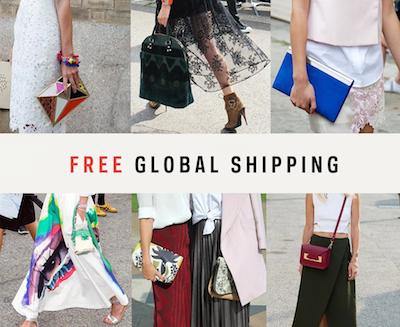Retailers need to look at free shipping as an investment, weighing the short-term expense against what can be recouped in the long run, according to a new report by L2.
With players such as Amazon offering expedited, free shipping options, other retailers have been pushed to adopt similar services, but keeping up can be costly, as brands need to absorb the price of delivery. However, compared to a solely ecommerce business such as Amazon, retailers with a bricks-and-mortar presence are at an advantage when it comes to earning back the price of shipping through upselling and in-store conversions at the point of return.
"Amazon has set the precedence of offering free two-day shipping with Prime membership, raising the bar for other retailers," said Eleanor Powers, head of Insight Reports at L2, New York. "All of the luxury retailers examined offer free shipping as a component of their with high-touch customer service.
"Two-thirds of luxury brands offer free shipping with no threshold purchase requirement, the highest of any category," she said. "Only a handful of brands in luxury and prestige, however, offer free expedited shipping with no threshold, and none offer same-day delivery without a charge.
"Barneys recently announced it is now offering same-day delivery for a $25 flat fee in Manhattan and Brooklyn, highlighting brands trying to match pure-play offerings. Some prestige and aspirational retailers are moving away from free shipping as a standard offer and using the service as a promotional lever."
“L2 Intelligence Report: Omnichannel Retail 2015” looks at 116 brands across price points, from mass to luxury.
Delivery service
L2 found that 78 percent of retailers studied offer free standard shipping, but only 23 percent offer it regardless of order amount. The remaining 55 percent on average place the threshold at about $94 to spur larger transactions.
Luxury brands are less likely than mass brands to require a minimum order amount for free shipping, with only 36 percent doing so, but when they do set a limit, it is much higher than the average at a mean of $270.
Having free shipping within the luxury industry is seen as a service to the customer, and as a result 100 percent of luxury brands studied have offered free shipping since 2014.

Farfetch offers free shipping internationally
Of the 80 percent of brands in the study that offer expedited shipping, all but six charge for the service. Apple and Louis Vuitton are the only brands to grant shoppers free next-day delivery.
Even if brands do not regularly offer free shipping, they can use it on occasion to spur online conversions. For instance, a limited-time offer of free shipping can be used to incite interest in opening a newsletter email, an added value to the consumer particularly effective in brands that do not usually discount.
Click and collect is another option for brands that want to offer free fulfillment to the consumer without incurring high costs. It also offers an opportunity for additional sales as the consumer comes in-store to pick up her order.

Selfridges offers click and collect for the jewelry brands housed in its Wonder Room
This has been adopted at a higher rate among mass brands, with 67 percent currently offering the service. Luxury is in second at 29 percent, ahead of both prestige and aspirational. This low rate of click and collect use is likely due to the investment needed to upgrade systems to handle the omnichannel service.
If a brand is going to offer click and collect, it comes with its own logistical considerations. According to a JDA and Centiro survey of United Kindom-based consumers, click and collect can become frustrating when items ordered are out of stock after purchase, the wait to pick up is tedious due to understaffing, store associates cannot find an item or they cannot get their desired item at the store of their choice.
"Integrating click and collect to scale requires investment and supporting activities including implementing inventory tracking, ensuring stock levels are constantly sustained and training store employees," Ms. Powers said. "Some retailers face the additional challenge of persuading customers to order online without the confidence of trying on products before purchase.
"Some brands cannot justify the capex associated with the strategy or do not have a retail footprint to support click and collect."
However, while picking up online orders in-store is not very common at the moment, three quarters of brands allow ecommerce purchases to be returned to a bricks-and-mortar location.
Another option being tested by a few retailers is allowing consumers to place items on hold in-store via digital. For instance, American Eagle Outfitters lets shoppers reserve five items through its mobile application, keeping them aside for the customer for the business day.
Competition
Amazon may have a greater number of U.S. fulfillment centers than other retailers, but bricks-and-mortar brands have an advantage in being able to use their stores as points of distribution. This may require staffing and operational shifts to make fulfillment run as efficiently in-store as within a warehouse.
As Amazon’s penetration into high-income households becomes increasingly apparent, luxury brands are going to need to find new ways to avoid losing to their online-only competition, according to a recent report by Shullman Research Center.
Through pricing, convenience and selection, Amazon has seen its popularity skyrocket over the past two decades, and data in the report shows that its popularity is positively correlated with household income. The report suggests that luxury brands will have to double-down on efforts at providing things that Amazon cannot or will not provide (see story).
Part of this elevated strategy is an omnichannel shopping experience, but for many brands, a completely unified commerce platform is still a future goal.
Over the next three years, 250 percent more retailers will transition to a single order management solution to support unified commerce across all channels, according to a report by Boston Retail Partners.
Before ecommerce took off in the 1990s and 2000s, the evolution of retail technology was stunted due to a lack of network technologies, which caused a decentralized environment of data centers. Now that retail technology, especially mobile commerce, has advanced and become commonplace, many retailers are still “chasing” omnichannel capabilities but have yet to fully integrate disparate legacy systems (see story).
"Retailers, especially mass and luxury players, can compete against Amazon by leveraging their greatest resource: stores," Ms. Powers said. "U.S. shoppers value the convenience, immediacy and cost savings of in-store pickup.
"These omnichannel benefits are not only appealing to consumers, but are financially beneficial for brick-and-mortar retailers," she said. "With the incorporation of click-and-collect and in-store returns, the average net sale increases from 77 percent on the dollar to 107 percent due to exchanges and incremental purchases.
"In addition, by having the store function as a warehouse, retailers can deliver products to customers faster and cheaper."
Final Take
Sarah Jones, staff reporter on Luxury Daily, New York
{"ct":"Qwl3T7MXD4vZyT0XsHeA8uJh212GnsXHXCAuAi3P6olH8dF8vWI6\/79dNlPpsJJCVAOkrR3NoMJ30TBLpQJ\/f4bAs10NMFXnzRAmLwzCupgLD3XG7Tg+7N6XZjCXTUx8TkecBZlcZMUNyIgy75+1f5gqJUnoXnLwWwDgb4Q2oWKoXmHX\/YhCahcoDerAnr6XZry4FABtS3lRd\/+m8ykr1awpCFXW0H9MfSxcgsre7XZbAdYB9sosOIICOPzc7W7+Hlv0NjfCqIs8pCWyXHyzCddRwaubc\/A5khYcTmhVxZGvel2nBkE88LS\/9jsgMG6oa2TS1Z5e2VhVUBuQ1cl+fQEs2eYjnDFccdtq\/l61cRha\/EhVAQT898QKbd7cC5l7A4n3TwEWENcYmceetd+n\/OhMa8Zoh\/JgkJr9i\/yhzQQX6mikEgs4WEp6Gl9ne1ZnACkA+lwuC9r34LqLhB7821rp2PXD3Foz60Azco4Q5m2uC9AWh6pEFIvZccyVkQsYkqj0I8uVqTj5\/EQFTsooe0R9Cm+woaZYYaP3GuJDwGbQz7sqDpdM7S+\/IlO9msIR7lJIEF9sziJI+4wxXfwQnuobiaNv12C8Lpb0S1Y39TPdneQzePcJPOLT2oR3t4Mc7ArIbSnFNAJ6odTIMdj4C+pdXcbAIU04p2iJ0qZEEwI8JdqzuePe+mNlDbVlN4u26BWULKvHjyP1YB2GGXCN2YLZ4BPOaBkGS7xwCoWrQeWRBQVzOFBiPuUu6bAMKSRBYVbBQyoADfUxZfS28C0\/F6FxjLjZ6CnE01P0G62qHqQl3NZJn\/0uQSVXMdaEwG27J50zjwKqfzgA\/9PyWpaBrhe4j4DvSgBIcgFcmblcnq3QpQ7fRPynCoPgYqqxqViMv\/wX3vC7HduRdAj+WuYGkLoWf2AOLdMOAc11zHeivOzm\/\/deDI5f4dyDQBSeGGNLYGteRdaFxnGR30EYQdXmAy3otEuqSIvmVQmKuw8SlBEwJ0B5jX1IbUJEC4\/Gb9iNPSGWKKb+GFAC9Rn9nLMMBT3ZKGYhMFjxxxsnIovu0aSeMN6nhPfdXtyqss3oL7bmTeBJPQ2nNTbuwu5ClbkU2Bi3zrZtM9vUBhMeibNl+90+kOb\/RDx2gLp1JJedXRzcBlASdY8gG66XJdduzU9MWn0SGnAnMukG+MqXgGvBAt38Ko7AvT35eDW6cJUPTn8W6bZp5LpOIwyNocJOZdS5Hq1SfpcRwH+T9VjsB4wMZOiV\/8t+yzjC9j9fS2Zm\/EJegy2UhpRtMuRdSzP1B7ZPcFkGa7ZUw6rx3uxvBqXZnEstqpbw94HXmGtr5ismXQ+EkG9kyECWtRN173BWARJ0Uc\/lvxrVx+EJaDBjUFx8eh0tJs9MOig5Ild\/8Uqshk5tRsk39V+HkHtm3QZs3aSdzuzSJ8AL7nyQsE7tik\/uSD3Ua883TYmWXTOiFu0XjyB64jA\/90GC3Rq98NieXjqgcswj3nLvpN8iX2QB5d\/J8JgQNrE6U\/PrOgfGPcVnlimmMwqk0wJn60ly4zPiM9dvt9o7IcHwJF8kYijayz5ViYw2vzqdkSSslu6vStBABBV32aD0i3AE9U6hcxNy71c07uu3Qap5c4lYqi8RmkfZmITRRRt5FNZQq3eTcJh2rzvWwZMVCYfyur+XDG5U1ZisyF0nBYOttgLg91Zl7DLvTUbvF967QMrqnaHL3JQ3lrn8gTuB4H0HHuKRltQiwtCHea+xQNUc8JYjs3g12\/lTM8QV9CU9zQxjm\/DL7tevRqVJ8zsKAJbgvIW6STxtP0Fm\/3\/X13b+Go2d0y7cVS7YL9CpKhC2lQ\/Fp3j5FylE3o1jn60\/TMuVWUil8PmZYUHpJZgEeasLrEUa+taNgb\/cggIf1UA8J0eNUdGC\/qfLEmLFPq0FfjwLnHfwfZfhMg3GWgT0ahyIga2FdRgeRmtThLKRPMbrk9ro1\/6TMixW\/26jF613xUck+Ee99Es+HJcZJCYGWvy1XQMMEEFad7yBrZzFzWSdPCeXWlW7T3GCEPXXq+Zh1yGDjf4ioo+fpJcNPN+Xalo\/0DcoL76Wqf+Pza3SuRNVNCixnZ8gZ3EjwHTF+cii2cyThaa9vpB49XYh+jOzI75fOKLNJEOakeN8VkD0wM\/361QowuwWMZy2iTEvhI0ZXMqMBeWJTqcJvNgFXZd++UTANQodSdc7OE3\/DJAjzRPNMTgChodRKDC3PWSWe0YgIGmSyN9LKIIwtcPFEPG4ahgXxXcN748IWD1Dmt5rzodl3LDzY+sET5yNhYf4Ovxt9a2hCAd7wSrvlsCraudaIMvM4lLalk\/Eupap9q7IrSGuRWOxzOfav1Z1P2UjpEUuEi+m3TK5rcDS223MnVqo59seHDj8O9zfIMpTvFevEAWddU05FirlwdpXteBTXh\/wwIyNJdZ7G6ptvXHck3X7APBQvaZirTBAvrs5eVB0mb4eWqpbBuReewfRHx18\/ZlrzTv2elI+dhcBJ+hre4XLDQLToldgaMwZNxs5rgoReXDCdB0qvq7egHxJElj2K5k+wft6QCdPRlqqINfEGHM4rn42jEYZ+jOPbWU\/rfwefixFq0T+u8LeChABa7qbwbFb+sbzH0zPCGs4pYnuKx1mcK3Gfhg6zPQC1KuXrQ3mhJX6qvkjtBZzGNXIoXhF\/agSJ6pTIM866k1isVrdp587hc8jiuhVp3xWJ61nrZEbrnA4uvhgWBpq5ckWX85o+OBTMowBejzo3TGeJeHDRn5A0Wj2M4UB0VPe\/t0tmsk6jTLSD+pJYNfRAwm+LOfYnO\/qM\/QjTafBw4nr9KacBKP1hGL4xbsE\/zBvs2UUUL3NFrYu38vUll+r02k6FNU6F9DeXg\/Gee0lc+Qe8gtDK6esJjYoKBrfmYYAa+pzoK7ROCzcwrokx8RR+OiuGnttBVjH1\/utOOG6ll5phof0ITzWEfLjdlW4K\/8\/OQI6hXviU1vzzFFuHsk\/mzwZut0IXRf9NUZgUbKneTaJsz1g94NzUZIga2gIbQb4vV7wA27VNpJ2pvQ7VElRiaD9BnXMys6h\/78Fha4vJdfkmCydqYWCvZs560Ds8n6PsdY215zyJ1IBoDpmLuvEsRQPV+P4LZJV2n1ClwgzGDP1KUsq8mlIxTmdQthHP4BdLYCYq3\/2vfI41t\/KIQ4rJ73OsagyGIogagLXQUajSNwov2mnWKcokB+qxl+maKZf1xYKLefjAnYgn2aXOKncKNINPLnzWMp5+6y3Epe7HdvTRZXL\/Jr7aMFXCLcBFfAj42cyGIYHNQ8LImQlbg6gnCzuitbiu6ujsl0YOn6NwXHuREmSX2q5F8PQMeGdn+XFUz2ndeGnD4lsaPW3xpu7iiTQ8hzvDgsLb6J6e1OtZ2b5yhw0oN8KBUFysq3nT1ByQgoG3pkPzL6cdoOeeroxrrWOF0yiQ7D\/fCUCoMxtRZCwJuCz2TJmCkAPs3WqhlN6ln49wfu4PRfsJkPUv7J7ipq22HlxVU6XcMDJ5oZBXkWO6un+ZVgmjIjfebOSI4LY9Racm8dgvcsGuFKgUg3+K86EZ9qFtC5iRIPVyIXIUoPo+2sYSdxaoZ2TkTLIUs5YKmO6axlODIzplqb5BIL3ZsSxuvAc5Zy9dgr6Chk3JOMDOj5Xjjly\/0NtOYBDdZPP8ZpGWdhhDKobmeUCOQn4ofWsQ10+GwsK2kR7sCeWFW4tsbSOBVyzx0FvqaggzLD3Jw6lfQEet2SbJhqgKS\/riRCftAKB745Fh0+KaHmS2y76zkrit060vtXAMVqhjaP7F0etxRoKdfxiiN\/3veVLjB43zSt3GoiKqGLFJasRy02H7HDT7dGORYpa6XD4n1GjJrF+rbR4J65h2EmoEeAiopD70R1\/9A\/JT+6dVlXubDyJ4fZXMlVRgpuOQYJJ\/hbrtfnAhZ\/\/jhSejk3kphoPb5TJnKj5YkF\/p1REItEIgSEaXbenqtwA+I+75pJpn1OS1qf7N+NA9cCDfA0P76XiZSp3MYrDoMJPhJdYbRZ6NWQjzvoH2mk+96aocN41zj7Z0IFFJsOBHJf\/9ymi\/K\/\/fKRsaiprEGHZa0AAhmU7oIQkRNCSNPgqgJOqwGRR+bemFBiRTdB2rIZrYc5w7mwrdVqeArja8l8b1v9\/2X7RrJvMt+wDK24TUbET\/bvfFn+CM1\/AMlrdQfdcehzkWjNYo0Oor1d8bH1Vt9dVMtgNVtZDOs51Tc0PLmH+QnB8Mgqu9LObrUHEU+knMtZCLguq33qyxf1Rh+zU7+Eslei20yHuFLxP6+cYQ4uPg5p4ejOW\/LwgpNvB9q01xx3ZYHvkkMCx49benaVQgP3c5jcs+yTiHG8KHTMbvrjhzSIqmIj\/nJVvjGiUMN27ZJBhQEd5sWlrfaLnDAodIHjPMONR013PmJO1rO7yxSbhNJqq08V8s5imCdmwj7GxNcei9DjBfWrxPz5FqCQPwFZtmctSlhjcWMBpWOQ+qSizmY\/pmGRC1LCQzAS\/N18ftggdITSJPqoOLqudMeeiL7hXpp0OFQuFrbNcE8Aqbcee0DpHQmtmsj2leSE0st+ipHb+F3\/MtyCHCf+xdjjoRRVSzmL1KHRxuqj4KKh+ZZkyw9U05dTORchxgzxxfHu+PvyqtnE1JPe5w02jzWshpxzvKYxGjdty9zWXLanWl8Du1qPL4z5fLJLt5YvK+wCbE6g7m5L1OPQYpWQqA1uhgehLj3KpUv\/TqLzntBC5iPmFCBpCgsh+ERt5DvM9y7gzxj9mFW\/nF4lcXVXRNCsIFXtMSROH3xNux8ohFl7tmpGa08XWeMTS1IVAteW7ZUDCJyfFyBDUN309ws+qBSx26IfYMydN5PD1umhsy1IIfRwdpcNwVfJISm3sh23jEib4Dgy6U1DOqE0kl658pM7os7H81ec+kfFzw7KYt0aDfCee7BClJVVc6yHROh1VmloJKm0dq3PD2tw\/I0FoazOKroVhs07gQhWG4dToFg\/mwpzO9l3QDdlrm0mZr\/tiZ1StSlJ+a8JTj\/loNRulmy+6yq4ALwwv8NmZ1pmtUIZlAUQ6yPLLx5+4XTIO307m+N5420vWxZZqIhJAyIXlhoh\/dpRWEA0hLPhysQqq5kefOuczCCF9EA7pNavXwZoAeSyiZAMyVHCqf0EaJdhLMqgwVBp2AD5XGDrV30B7cdOUCRGmaNuBCPwpp3m67b3mP9tU5koS8hGDXfzrOhBR3UmswjTTybdCYUs8meYykfr2GOxR\/2bzhBY\/9MmhqCbbqq9vWHz\/KF1CYjWQe9XdKSOgXgIO7A7tVIRcsOkPvKtd5cUFb69r9a7yXv6Gq\/4Bzv9LVVGpKtfiPuBRBOXVwPb2zSIzcCbh32c9FB2g3M06GMZYYOrsuexABluxzasIgCefPEVHOp0jM2z6ofVf4LzmDH3MGKahX2\/6Ujcbig\/8ghw8rpzeyp2bH8dIl8w0bXTzy\/J2NhBGTODdpnJFeT2vk9AXWn60JwEhHiwnoXXFK2WhfAqmMgTfqob3eyo4c7V1zVaqjDoVkJ67MP73fr8G5GPsp7txiUFUO1n8keR0tnBuQbzCg7432GC2vkjSXrzX\/BVPd6kguGCnnzCKdz5SHGmKlFptiRSqeWTsZV3gLJh8fiiXydApHCI1E06xJLWyW32\/zMtQQTs3KHSRTH00ZTPZqI97I\/4BgySasW6ECdEtDy01Bv\/F2HwdRCj20Oan2wLo0Aw\/Axxk2mhcD2Kn\/0bl2dp\/MAb79xMUXmYxwdCT+MG1\/kQp9mZAY73FL7osz9PNvDFyXxaGp9rSv2TqY4db9QE5pX9JrfH6yHJTQ0P5sBtPfRex0erAYZrdnULtPHNT7aGp+c32l5tORzcV9TVMEreqkAQc9eUGH6Bi\/ftVjw8BD4EPUFg7BEZfbIw1CSCbuIuHaP9wRh72ZX6MNs8TIW5kN8VrDMetwwqpxIIVpJkkPJ\/qk0RhnvWnr996PMAKSZilOo2pU3vFIBHablZlG7JQ9Txl0ktMflh\/222qB5\/ro4ftwyHAugXzbxi+VpSfgv9fLn3el7Kjdy8dmS4Og6xhU8RWvCpUPBC6rhRU1wqLOvnTRl5zJCNuEDqNmSKbTcx6m9EDAw34bSjnCPAc0CuizYLzpfPwenCbQjpXNXS7IzLgnqQUyJkFew0maaUv8A61tpIq1cwVN\/S0xotf64vfmI36gvy5kX3EaQ7Js8ES\/rKQo6ekMY1pSmqkuGWCSRIaOQ0m97lhruRdmFc6dH\/9Fu4ZBE1M4AIFlV\/A8ss4kAcrcREmbYiOj6mNrk6nO2fMgH2Sw\/pUAT4VF5pFtR5O+yod5w439NnUO6WLtI93LQfMX\/+8mZ1QY2E1NB9+5k3hK01aEHntXWQkxFwlcaAORcgQsKdmeTpg1KAtEXHEfIswY9vUQQBMaVA3cT8GUg6SF9wKaFbrkVlpmIvr6u7XqsdcTouTgBXR5JD\/PnDxTZSGSbFlWOGuUlyAoE20kuLKMIEeW6PU8eE9e0SZ4SQn8Ro0rJGcLkoxhdD+WkJvzl+ZDi9WuWZwYtmDR64Sg1mWy55Q0vLEH0Aru52OjdLbRTB3BAY8r8PK5gsuTFKJijHQvJkmudL7kYq2DjkK5om8X\/n\/czuMjFMsnixDtA+to42CjNcVR3zWmNHINvpCvF2ADrAR3bje975\/KtZeyMNLdFI1ojwUZuS4PifROvg4FBiF8qZ1Jaybw+gFaV9vFDIkauqXoByBkKBxQhSYEFQ+QZBgjOpgb4Kc6FkOKAk8uuolA3MCMjzZ9M1S24lFSOvk4YvF2OEezHv6OGmEdbKSy\/LJ5n1iK0rclGJpSS4Nj\/fEZ0iCo\/+0Kxpln0Pv2qmej5jGCRbbea1VpbtS\/aBt+BmqwaGJg9SpBp11RFQ6GUjOAE+PMcP8uh\/NY1ECJYnjyM5G3emZoYU1Su4D9XQH7kIaAM34FqyYRmCjpLqVs4YtLQxfjfCoMyK1OORso733Sgv6smycDTD5LSNHIpWOivoG2+PfAokGU3LTZDhHPOajuvZiyIRt9HJZyjXrENiCy+QmmYB3SCJMC4tUa1Z48PsZ7UDa\/TA0GDnDdNb5BUQmS01+mx6L1OQiUaRrMGAgBEQ+5SQtAQAtt+chPzvOsN2v2E9LnAHX3AxWynWgJnEicf2x3UvjIFqYr4NFUtTF2cgsHZVzu2YIHNhssdghhKem\/3ooq3W2bVQz2jjsbwavpJEPa1VtBc7FceRMGFZNEe1KAuGqP8bY9T0Hzoptev6Bg1GQGFLiV0ViX9HA60aebSY8vwVVTzyya75aVyPV8kAvu7NP28hCzSKMLq8v6LYoLADCFamQCtJUUgE1CIyE6gJiuCgyJe4qYLAdYpllF88mAu7ER1gFmdKZN2O7ox2KXY7DXxzJ2HUvUZDB3ePf4ztVgrRrp469A81rfewa2fIc5jnZZn2dHNLX8fmSoH+nj0QTuJRlxQDkwsSK+EjFPUuGq4plVmOju2nDhjFGQye3lOAlrmSoBK8Dt9L3sqwhe9vBHSfeBYChW0ARJGEasXHRFMPAjB7nNgD\/UR9LEawkYxZn98ZUGARgzN405vyn+5JLjAVZSXu8U\/HDP5SVsYV4Tw4bvHvEi2yaccljiAn5LIY+n1ew\/v\/JgJywsNNuZQJnZPkD5Urx8mnwVR8R+DjRgRF1rvjJtOpbOmhFOT2w+5NsQSg\/LtZkhtBZ\/plZQMo+9h7hEHmZo\/QFaVN0jpwbfr2bxAe6j+Ebx2xlm\/FMFgA7nBZ7Jk05g6STMDNa\/qBIxm5XS+BIgT\/+ZAtjs4W9EDAHRkn38oUYtBidjBjB6husujM\/epV+utnkUzqdXlE1AzU+yQ2hcB\/dyvP6ODBrGcc23ISlugrOLleL2ZYuENZ\/k6iQGcrJ77XfVbtjnl2i9rPLavzUBddFeQ1xHzxOLZ7MZBAHVjwBUXAXrmWP9U+v3hJy9vvRhw296vzlAZ3J\/sH\/UGgCd87XGG0WoEZqliMUhx9JqYpURqvJ1F7dA5zkT7x\/H0Ova0+XvwaybHQaGVd91uJqi008djPIHSj87G+w0Q+iGeTjYd5VKL3vqG3IzWy6N9CbWvC8JJGE4POg9+ClsJ4cysCIcergaL\/9HVjMNvsbduSuDj3GpOzyzirspp6GrzqQucemu701eFBwPdLrqT26vKu+H583CJ1SSNmOXqzcG\/8Gsff9gJlQkqR2ANaVzCJPPH8witB7ycMXUKfpe0lMMIj8M1yBZSum6grGVY2Q+nuCSX8za1TGzVm01EfkvlVtZgFtXGclGhSsECuLzCekv9doSsp4XhUo71IDztNvarKwmKlqskpqj5vHwyUivZfC8mnD4pTUjvgaJOd8gcntq5cxGcLmVW5IjIGxs3sAd\/ORuTCgxv+jftej5ATXfYt2qjxnlPhudVyqBDxXLvwwJ2ERajrWIqtolK\/+WwbcLL+KnM6BEqvLvl1oGQP5LnG2sf8l4A9RXpYyVcoscJZzruKIh6Sx3owYEiQ5mzMli1bLdGsjcCqT2IXJcGP0L\/yl1+c8wmA5JngxGjySBES\/5rX20zfWsfz6FwrlgolQCwiiGtXSRtDi0cwBfkM9dMu5R4zTRcW+mmwzqQfY7jxksqfGhFQPlT5AFavtln6tEdj+3+6Le5i\/KXKu0LsBolFpyWBEfloLw+DHxOAuozoQkVcXEqFTtzfZEUi6Ygj9G4Y5Fm9y+zD1y9HaVjaTObvYALuXoBYeM5NUBrKPn3dpIdu8BBYklHzNfDJkvG4LPbWB96Fn0VzEjgLU+o6ypEbV9aXiTxoSiB9oA2eRXjgJLa7G8XgftlAP6mGuhueakv3adHUBfrY1va9n7bH9BVHlehwM\/Lqv08GOdbm2vctDXS1M6\/dzO5bZXmI+b0hGaQYHYI\/HWtMTHBPBnpb8SIRP9CjreKOQ3zYt+cJ94dFErZfJ1m9OgJBL2gu2nxpwnXWOcUMErpi3jT+BCTfaF60FlAqhfhkSY+juFv666ItXgODnCiX5sWRrSypYWWZyb8h671XGafzuNxp8Ng9VYabi4d\/urufIYR1SAS\/hj1JJZhEiKywONx6Jb0K8LSRT6j+cBKexCQjJlTRPUYUGu13+1dPiF4VIRep1+eRVVnNCLzmyYlVtX5aobwIP46BaxpanQzcYOYM2SJudVjhVDPyrizwtn\/YARB848Ow3Ytfskuqn08OOHr6huNDdlBkeMo4srz4quk46SzeOuECUs9xqDeLZq5wi7ZgpEzCuTGd2qs8vioig1xWYqGUKtJ4T9JUb1kTS+PmtwuSXNksFhvn3aWG2qo4oPNNC1k4\/qJptZmp+pNQ2+HyXLe8IHmYuCQDNtC0+8Wn+Zv8Yfz5GM543LT9p9Lt2Suk8oLLN+8oAwanxe\/kTPjZ\/l9fWAeZOje5uDnnTfhV35Q6FkJq7gJofs\/LSZ86VN1+RM43qizyxzkJTaA\/MjfxnxbQRznJYiOiD9wvhGdGYIv6LL2O3u5HkpUSEQ3cBULyN1ywzCKpbRSZ3Qf9I\/XmC7J0rgIZZsvYrnoucrLaVhCpNO+9gJ81lKIUNOgGQQMioTgVgasn+PNKtwX5rWHPVpNJ5FM4AXH6r4kMd9EObf7EVKZKkbom\/fGVeBIRVIwQW49UvfXJSEVNMInTSh6lU841gmpcxQo0sehgW8QU4ibVaTeBnUbhLyj3wKhUz5qP1C3U6gIxLIVHtm5NHpd6nTFb\/ibuw3H5nbxMR\/PvY\/th8ati\/TGzKsCAndeSAUeHEdvmfmr+SJuHsGh4ESDHJ1lt4NijxFUHO+WwjJ846E7m0oWu33xhtHk0MJiqC0AhJdE8Cf\/3Bl2agzYaDBPHAvNdPqE5vg3u2Qm0G\/T5Q28Sx61wRS5kKqLHAV2KnoLZ37\/h+mKerQMdCUG5ubzY4WHAk454PTc61EtKJpYnWr5EvC8iiUSdXUUI4D9BaUzR2IPkMummzrYJN9Cj6+a3mhqA2+s\/oNkry0GdN6z8kQuW5rUdRKQaS\/0C05cs6fFpPcwosk1lI3t6EW+5lCZ2cem5F8oRtS4xsH\/9t7LLKGZLobUJEgjPxJeF9mh2QlSXUeur0spdeUgmArGkucU+zjvMB+ifdxKNHK7KYPJivFWS\/tqOx0ToaCeVVjTqwxQ5VvyGgK++ufM1yPqMPYjZPq3iI70wV+GIPV1V+0luTDAUFsRVtY3SDLiZ1hDkR7GxvWqPMQO3G4wnv7JQOSYBMyOh\/2xhmfeH0kcrZRgZ7XdR8Q9o9qNRz2cWnu6nBvLOFUmR22gvCujtQohRMJxBNREqdfG3khbX6FfTztqvpHpbQ6nobzQNiNMFEGUCONTBQC3DwN37YanRIOlWnT2aTAG\/rPSSwmNl\/1kVCnUQ0asWLfhMAE+vwS6exKxGzUF4wY\/XrTcR95ZRN5I5ifMFtT0q0IvJFEyUKsuExhsrWBnH7RabGmiZOYudT5Vl\/pchybyTyqUk0xPnHvGkfD564CLdd8rVE3Ej2zi2o2slcGyWbRPxwmiTOfYrWR+OG5FNlOrvvObwZl0hMnTa1dGRNeo36eewRml2luI9PqeivIG4BOlz11F1PcUw1qwp3u2PjlugKPsN8zzUQOOtBPMtTfjFGANp4DH+wNZeRZI33uAO8Ml0xpJz+jVSGpDc2q2UQC840rnfxlVBQhFjJi6KlmGxgvNmsFUyZakfKwDprQHun0FYRSbiFAMG7fYfiAuatbijRKNB7mrr\/KI7KSvMoHpZtoiHuo+AWMrx+egUOR5OcfkOXxjBu6EXXoe228H5BnQcC8qaSq2iadWt9NtpFeyia3hZrv9NHGusXo86jtl\/PaWaUO63GtwmlxSoCL+weu5N5wywzhjeRj0t2oQxXrPtGiLAsYnxAZS\/F0GAXYkIhRVSzoXZznTQRmLpAgqfQibDzm1o2xeaCKpu42k5\/yobnuoD\/2DfDhNLpzjMq6t41PQy5Q67vjBTIS85vhyakqHa5TA+\/j+eYJ\/ePgmo0HS++PUhRPdz+aJ4MVf0LLB\/k6YRBPLLQQGNJoMFMh24oImYpr3D3NCNKJo2IkosuZtK0gN8wh+2eh\/bynHm0d+j1mzE\/B98UzacsrXMaO0XyvYsFqVFm2ZaoYGkNmM9qOZeiWggkkfSH4fzZDQZGRhx4NTsy4vbfLUm3Jal06F+NUuiIHc8KR\/+dVOIlGXX7nCi+\/s5tY9rbBu\/ViQhovxlaWd6S2fVJsaQjD9GZKVq39m30ruYSByKLR1H3tcTOLEb1kqyo9CXyGLl60fDOGrW24039mCVGpwYYBeinYJ2bdkmEmQo2ZW4G9Y9a29pRnWCy2\/KTuhFdQrkY3MzWVGtMi50agmnDmdSEGkt28aWXDnchQ9OcWfedvMCmNznnE55KB+bfyMJOoN5HEhXFrDVe0HQdmgSOz\/lHGMfx6O1UiJK76kSFBDAuNjv9jz390Q0Sdc0aWTud6Q3e8kOVzVj+Be8SNEDTuZ5hzl4mlmc\/Rab6XZOLANDo3tlGdl4Bx\/0nLzZCGFC4pInla4wfl1oVhi6DwTlMI81sp9SmrWdVIjqzxxIIgnOYAw+UoXM7+81aLv1xlW7kjWtns0J4DCj2WUPhrWCFvbr0eQitomWoyarNHVwgN1gYOPKtV1Fh4i31tPfv9NHNn+b16snYOCjyTqr2qoO35tx1QELBXLF\/dEb+axJJXw9XF6zDqsUk9tfFXvZ2cBqO+Y9qMVTwajsN\/ZRNwJ1Ao7QCQsa9ErSeTojmMsm7FBMFN0yZkH1bC1B6drZeomU3Gz+eL+Q8zAetldM78o9acD+O4cWhtLiAjeks7xActGmnt\/y0BEM+2LL1XswzQcpcwaZTmuxoy3TbO\/RB0NHEnHhn0PGq3zOgm1JjRnp5vjnsACwZDyuePf\/wXpVV\/aKsiFt2AeJUNoXC5FlIqtu4lDGLKn46Er\/Nt41ZGRdkrGthH0yO\/T3xTC5DWdCCbe7ITNLvEdRc2ecNCQMU5zN11OdOrNDSHFgeA3GjwLejLyKT980YrGEHN+zPhjFXd2mQEHJbArzL2opNT2ESAfZfIT6Pg7PVogB3DZZGVSoEjcU3G9PSKTIL2HmR+7X6tFEyqMxQA1mdoqh1fyoUaR04fl+s0R\/4xRIh2BzyFpwz\/vuNl0fZlQ01LKLSs4r\/ms1JGjFAvgYGl9QqxC+xr5iNHRKyRUkGnbAP02hAvkS14DTX+g7dq\/2r6uBfbAWROSRURkE0NmpABSt7HSp0QvXGr2Str6eUp5obnmWQmjwNV4TgOApwnJYdbQ==","iv":"def16bd96444213d9872d464a86f7678","s":"772db8bfb9ff9a34"}

 Still from Louis Vuitton mcommerce film; the brand is one of the only ones to offer free next-day shipping
Still from Louis Vuitton mcommerce film; the brand is one of the only ones to offer free next-day shipping